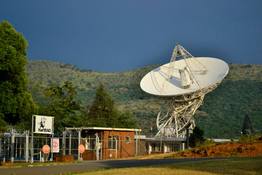Hartebeeshoek Radio Observatory

|
|
| Website URL | http://www.hartrao.ac.za/ |
| Contact No. | +27 (12) 301-3100 |
| Day outings ? | Yes |
| Camping ? | Yes |
| Area | Hartebeesport |
| Travel time | 60 |
| Province | Gauteng |
| Description | Hartebeesthoek Radio Astronomy Observatory (HartRAO) is located in a valley in the
Magaliesberg hills, 50 km north-west of Johannesburg, in the province of
Gauteng, South Africa. The Observatory began as Deep Space Station 51, built in 1961 by the National Aeronautics and Space Administration (NASA) of the United States of America. An 85 foot = 26 metre diameter antenna was used to get data from, and send commands to, many unmanned US space probes going beyond Earth orbit. These included the Ranger, Surveyor and Lunar Orbiter spacecraft which landed on the Moon or mapped it from orbit, the Mariner missions which explored the planets Venus and Mars and the Pioneers which measured the Sun's winds. The station was handed over to the South African Council for Scientific and Industrial Research (CSIR) in 1975 and was converted to a radio astronomy observatory. In 1988 the observatory became a National Facility operated by the Foundation for Research Development (FRD). In 1999 the FRD was restructured as the National Research Foundation (NRF). The original function of the observatory post-NASA was purely research in radio astronomy, but a new science developed at HartRAO from the 1980's, namely Space Geodesy, i.e. geodesy using space techniques. The radio telescopes are used for both astronomy and space geodesy, and we have other dedicated space geodesy instrumentation. |
| Activities |
The content of each visit is tailored to the needs and interests of the
visiting group. When you book a visit we will ask you about your
group so that we can tailor activities to suit you. On a visit you could,
for example:
|
| Highlights | The hands-on activities were really enjoyed by the Cubs and Scouts. The tour of the facilities was interesting but a bit long for the younger Cubs. Good facilities, mattresses available to sleep over, rooms available for Scouters if needed and they were happy for us to put up tents if we wanted. Very accommodating to what we wanted to do. |
| Concerns | Arrangements need to be clear. There are telescopes available for use by the groups but this had not been clearly arranged and therefore were not available on our visit. If you can bring your own, even better. Weather and moon cycles are important when planning your date |